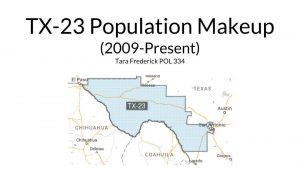
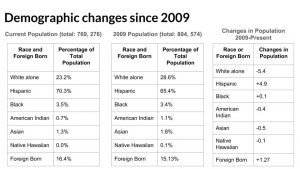
This slide shows three charts which show population demographics of TX-23 today, in 2009, and how they have changed in the past ten years. Overall, the shifts in racial, ethnic, and foreign-born populations were fairly insignificant. The greatest changes were in the White (white alone), Hispanic, and foreign-born populations. There was as slight increase in Hispanic and foreign-born populations and a decrease in the White population. This is not very surprising considering that increases in minority populations have, in the past, lead to white citizens leaving an area. Considering that the total population of TX-23 decreased by only a little over 35,000 it is not surprising that demographics did not experience great changes. TX-23 has not been redistricted since 2003, its economy is fairly stable, and its socio-economic traits have not shown notable change in about fifteen years. This means that many people are not moving and staying in their homes, so demographics are not likely to change.
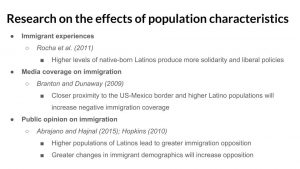
This shows the conclusions of previous research on three effects of population characteristics: immigrants experiences, media coverage on immigration, and public opinion on immigration. Rene R. Rocha’s “Ethnic Context and Immigration Policy Preferences Among Latinos and Anglos” explains that higher concentration of Latino populations influence greater Latino solidarity and liberal policymaking. Regina Branton and Johanna Dunaway argue in “Spatial Proximity to the U.S.-Mexico Border and Newspaper Coverage of Immigration Issues” that the closer a district is to the US-Mexico border, as well as higher Latino populations, the more negative immigration coverage it will experience from the media. This would lead to more negative media coverage of immigration because it would be seen as a more present, high-risk issue, not to mention that districts closer to the border are more likely to have larger Latino populations. Abrajano and Hajnal discuss populations’ influence on public opinion in White Backlash: Immigration, Race, and American Politics. They argue that higher populations of Latino citizens will lead to greater immigration opposition. This is true because of the threat narrative. White citizens will be more likely to fear immigration issues if the ‘threat’ seems more present. Similarly, Daniel Hopkins explains in “”Politicized Places: Explaining Where and When Immigrants Provoke Local Opposition” that changes in immigrant demographics increase immigration opposition, especially if there is an increase in immigrant populations. Like high Latino populations, this presents a more prominent idea of a threat, as if immigrant populations are taking over a district.
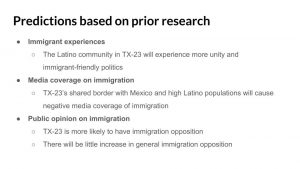
Based on prior research presented in the previous slide, one could predict that the large Latino population in TX-23 would experience more unity, solidarity, and immigrant-friendly politics. This would make for a more positive, welcoming immigrant experience. However, this may not be applicable to TX-23 because even though they have high Latino populations, they also have high white populations, which would increase the fear of immigration and Latinos and anti-immigrant attitudes. Media coverage on immigration in this area will most likely be negative because of its proximity to the US-Mexico border. TX-23 shares a large portion of the border with Mexico, so the media would be more likely to show immigration in a negative light because there is much easier access for immigration along the border of this district. The fact that this district already has high Latino populations increases its chances to experience negative media coverage of immigration. Public opinions of immigration are likely to be low in TX-23. They have high Latino populations and have experienced a slight increase in immigration in the past ten years. These factors, in addition to the negative influence on the media, will result in more negative views of immigration in TX-23 because the ‘threat’ to the community is more prominent.
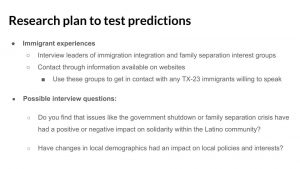
Examining immigrant experiences can be done through qualitative interviews. There are a great number of immigration interest groups in Southern Texas. Leaders of these organizations would be good candidates to interviews because they could give details on immigrant integration in the community. They would be fairly easy to get in touch with through their contact information provided on their websites. They could also provide ways to get in touch with immigrants in the community who might be willing to provide information on their own personal experiences. Questions could be asked about lifestyle, community involvement, and community solidarity. For example, some of these questions could include “Do you find that issues like the government shutdown or family separation crisis have had a positive or negative impact on solidarity within the Latino community?” or “Have changes in local demographics had an impact on local policies and interests?” These would show not only how populations influence immigrant experiences, but also how reactions to local politics change immigrant welcomeness and reception.